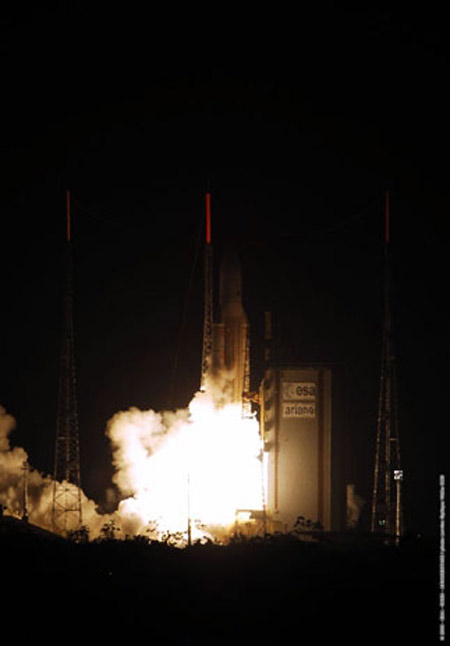Ariane 5 Rocket Successfully Orbits Satellite Pair

KOUROU,French Guiana -- An Ariane 5G rocket successfully placed two telecommunicationssatellites into orbit Oct. 13, one for French and NATO defense forces, theother for PanAmSat Holding's U.S. cable-television broadcast service.
The FrenchDefense Ministry's Syracuse3A telecommunications satellite is expected to be inservice by Jan. 1, in time to honor contract agreements with the NATO alliance.NATO is leasing capacity on board Syracuse 3A and its companion, Syracuse 3B,to be launched in mid-2006, as well as similar capacity on British and Italiansatellites as part of a 15-year contract valued at 450 million euros ($540million) to be divided among the three nations.
TheSyracuse 3A satellite, carrying nine SHF (super-high frequency) and six EHF (extremelyhigh frequency) channels, was built by Alcatel Alenia Space of France andItaly. It will be placed in geostationary orbit at 47 degrees east longitude.
The secondpassenger aboard the launch was PanAmSat's Galaxy 15 satellite. Built byOrbital Sciences Corp. of Dulles, Va., Galaxy 15 carries 28 C-band transpondersto beam video programming to cable operators in the 50 U.S. states.
Galaxy 15also carries an L-band payload for the U.S. Federal Aviation Administration. Itwill be integrated into a U.S. system that augments the performance of the U.S.GPS satellite navigation system. The satellite will be at PanAmSat's 133degrees west orbital position.
Get the Space.com Newsletter
Breaking space news, the latest updates on rocket launches, skywatching events and more!
Join our Space Forums to keep talking space on the latest missions, night sky and more! And if you have a news tip, correction or comment, let us know at: community@space.com.

Charles Q. Choi is a contributing writer for Space.com and Live Science. He covers all things human origins and astronomy as well as physics, animals and general science topics. Charles has a Master of Arts degree from the University of Missouri-Columbia, School of Journalism and a Bachelor of Arts degree from the University of South Florida. Charles has visited every continent on Earth, drinking rancid yak butter tea in Lhasa, snorkeling with sea lions in the Galapagos and even climbing an iceberg in Antarctica. Visit him at http://www.sciwriter.us









